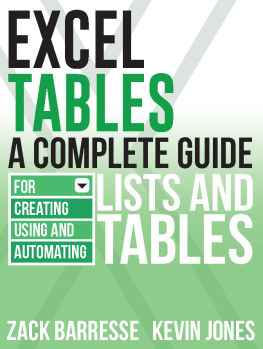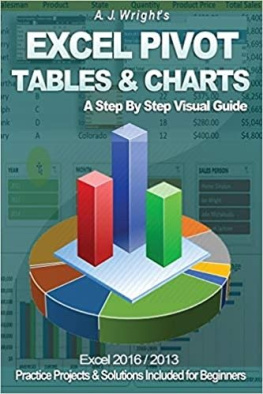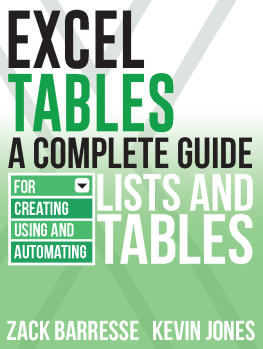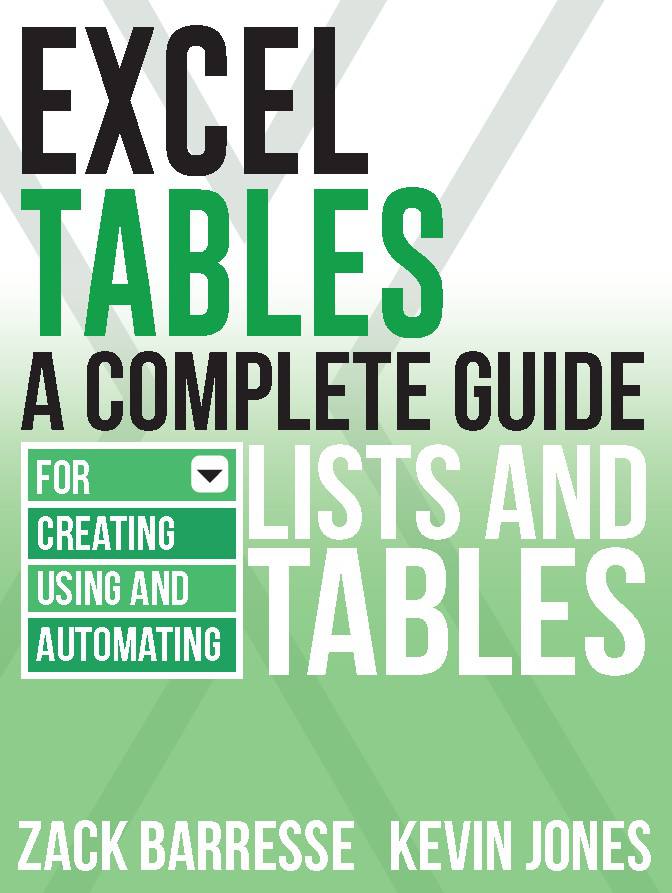Excel Tables: A Complete Guide for Creating, Using and Automating Lists and Tables
by
Zack Barresse and Kevin Jones
Holy Macro! Books
PO Box 82 Uniontown, OH 44685
Excel Tables: A Complete Guide for Creating, Using and Automating Lists and Tables
2014 Holy Macro Books!
All rights reserved. No part of this book may be reproduced or transmitted in any form or by any means, electronic or mechanical, including photocopying, recording, or by any information or storage retrieval system without permission from the publisher. Every effort has been made to make this book as complete and accurate as possible, but no warranty or fitness is implied. The information is provided on an "as is" basis. The authors and the publisher shall have neither liability nor responsibility to any person or entity with respect to any loss or damages arising from the information contained in this book.
Author: Zack Barresse and Kevin Jones
Editor: Kitty Wilson
Layout: Tyler Nash
Published by: Holy Macro! Books, PO Box 82 Uniontown, OH 44685, USA
Printed in USA
First printing: July 2014.
Cover Design: Emily Jones
Indexing: Nellie J. Liwam
ISBN 978-1-61547-028-0 (Print), 978-1-61547-219-2(PDF), 978-1-61547-340-3 (ePub), 978-1-61547-119-5 (Mobi)
Contents
Foreword
Zack and Kevin met for the first time at a Microsoft MVP Summit in 2006. With their mutual respect for each others skills and talents in place after watching each other post solutions on Experts Exchange, they became friends and eventually started working on projects together. About a year ago Zack approached Kevin with the idea of writing a book about Excel Tables. Kevin, having assisted with the writing of another book with Bill Jelen, Tom Urtis, and Tyler Nash, was eager to work on another, especially with his buddy Zack. Both had been using Tables for a while on various projects and felt that their value was understated and underappreciated. Thus began their journey to bring the simplistic and easy beauty and function of Excel Tables to the rest of us as well as the Excel pros.
Kevin is all about elegance and simplicity. Having worked for all kinds of big and small companies in several different industries, he knows the value of good spreadsheet design. Once he was hooked on the benefit Tables provided, he never wanted to go back. Zack, has always looked for the most efficient method to getting data to just work and look good while doing it. Together they saw a void in the availability of educational material illustrating the power, depth, and value of Excel Tables.
In 2009, Zack was hired by Microsoft to build many of those fancy templates that you see when you click File, New in Excel 2010 and 2013. He was directed by Microsoft to use Tables in each template. So he found himself using Tables a lot over the course of working with hundreds of templates. What he quickly discovered is that Tables really rock! They are brilliant, dynamic, and easy to create and manage.
Why is this book worth it? This book has all the fundamentals for working with Tables effectively and efficiently. Get more work done faster, more efficiently, and have your data looking better than ever before. Its said that less than 1% of all Excel users actually utilize Tables. Weve found them to be amazing work horses and have shared that knowledge in this book. Make all your work look like it was implemented by a pro: dominate Excel Tables like a boss! Everyone who picks up this book will learn something, whether youre a beginner in Excel or a seasoned guru. Wherever you stand on the Excel learning curve, this book has something for you!
Here are seven reasons why you will love tables:
- They make formatting your Excel spreadsheets easy and make your data look absolutely amazing. For more on formatting, see section Table Formatting in Chapter 7.
- They automatically grow when you append new data, making them brilliant data sources for PivotTables, charts and dynamic lists. For details, see section Table Behavior in Chapter 2.
- They always have a calculated total row with easy-to-change calculations. For more on the total row, see section Referencing Tables in Chapter 4.
- Sorting and filtering always knows where your data is, so no more asking if you want to expand your sort range, and your data always stays together. For more on sorting and filtering, see section Sorting, Filtering, and Using Slicers in Chapter 6.
- Formulas actually make sense when you read them, Excel Tables creates meaningful names with structured referencing. For more on structured references, see Advantage of Structured References in Chapter 4.
- Tables make data validation and dynamic lists simple and easy. For more on dynamic lists, see section Dynamic Referencing in Chapter 4.
- Most external data sources are brought into Excel as a Table. For more on external data, see section Working with External Data in Chapter 8.
For all the good that tables bring, they also have some major annoyances that will bite you if you are not careful. Here are five major gotchas to watch out for:
1. If you stack one table above one another, the lower table has to be within the same columns or narrower than the first. For details, see Table Behavior in Chapter 2.
2. Entering duplicate column header names will automatically change headers without warning. For more on column header names, see section Table Anatomy in Chapter 2.
3. Using absolute standard cell referencing in a Table wont update formulas properly. For more on absolute cell referencing, see section Calculating a Running Total in Chapter 4.
4. Sorting a Table on a protected sheet doesnt always work. For more on sorting a protected Table, see section Sorting in Chapter 6.
5. Converting imported data from a text file into a Table breaks the connection. For more on imported text data, see Working with Data from Text Files in Chapter 8.
Introduction
About This Book
Inspired by the millions of Excel users who often underestimate the power of Tables, this book aims to increase the knowledge and skill levels of everyday Excel heroes, junkies, and anyone else who uses Excel to make their work and personal life more productive. It will help you become more proficient with Excel Tables in their current form. It will also help you learn the strengths and weaknesses of Excel Tables and how you can leverage their functionality to empower a more rich and productive overall experience. This book is written for all skill levels; anyone can benefit from it, from a novice who doesn't know what a Table is to an expert who has experience with formulas and automation using VBA.
At this writing, Office 2013 and Service Pack 1 (SP1) have been released, and the next version of Excel is in development. Excel 2013 is used as the basis for all discussions, images, and examples in this book. Any differences in functionality between Excel 2013 and earlier versions are mentioned where relevant.
Special Elements
In addition to providing information in as short and concise a manner as possible, this book includes many additional tidbits of helpful information. They are presented in highlighted areas labeled NOTE, CAUTION, and TIP.
NOTE A note is an interesting side topic that might be of interest but is not pertinent to the current discussion. |
CAUTION A caution is something you might run into or with which you might have troublea caveat or warning about a possible pitfall. |
TIP A tip calls out a technique or fact that can add to the quality and value of the current discussion but that is not necessary to realize the results being presented. |







